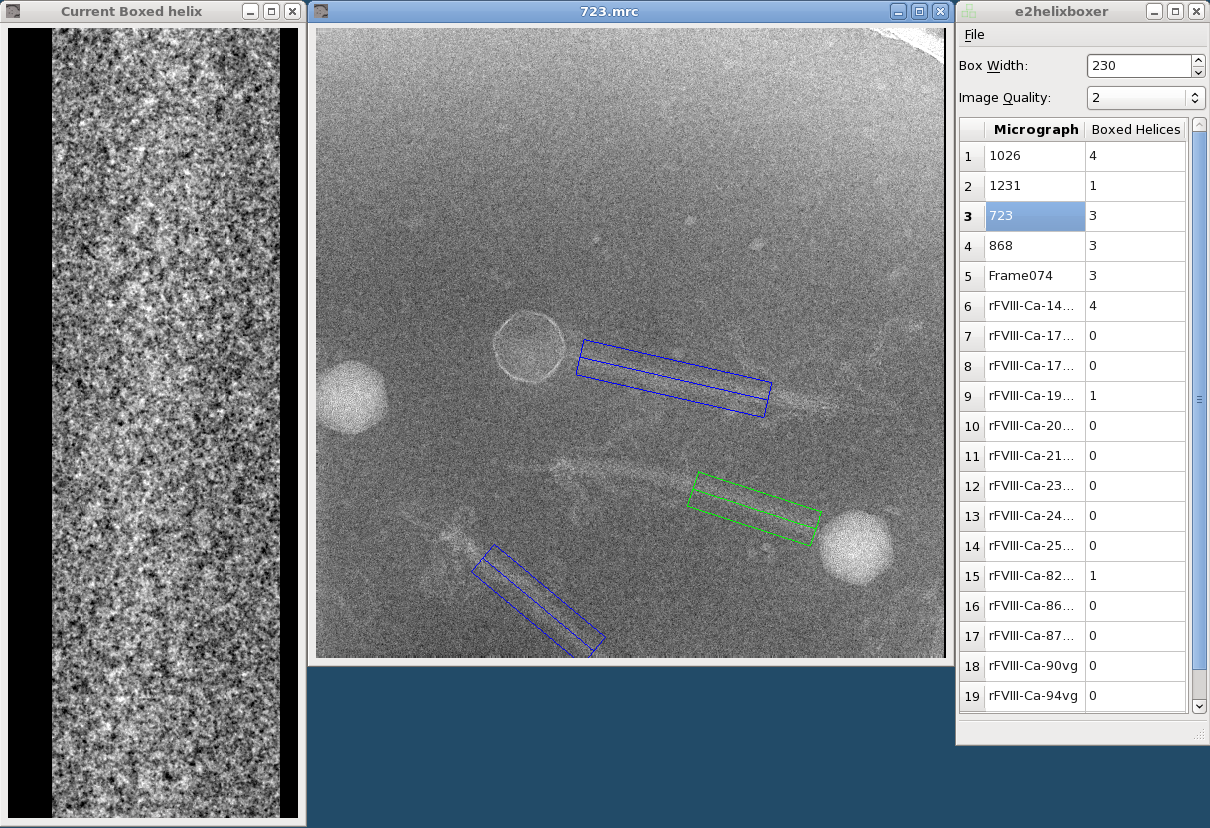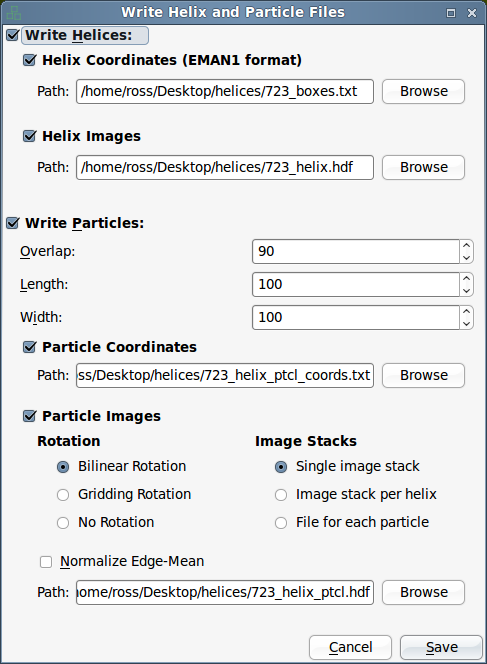|
Size: 3277
Comment:
|
Size: 4982
Comment:
|
| Deletions are marked like this. | Additions are marked like this. |
| Line 3: | Line 3: |
{{attachment:helixboxer_diagram.png}} |
|
| Line 33: | Line 35: |
| A. Write Helices checkbox: . Helices are the rectangles that you boxed. You can save their . 1. Coordinates to text file using the EMAN1 file format, but with a default *.txt file extension. . {{{ x1-w/2 y1-w/2 w w -1 x2-w/2 y2-w/2 w w -2 ... }}} . where (x1, y1) and (x2, y2) are the coordinates on the micrograph for the helical axis endpoints, and w is the width of the helix boxes. . 2. Helix image data to image files B. Write Particles checkbox: . 1. Overlap: Distance in pixels that two adjacent particles overlap along the line connecting their centroids. Default: 90% of particle length . 2. Length: Distance between the centroids of two adjacent particles. Default: same as helix width . 3. Width: Width of particles in pixels. Default: same as helix width . 4. Write particle coordinates: For each helix, save the coordinates for the midpoint of each particle in that helix. . 5. Write Particle images: Save the image data for each particle in each helix. All the particles in a helix will go in a stack file if the file type supports stacks. . a. Normalize edge-mean: Apply the "normalize.edgemean" processor to each particle before saving. . b. Use unrotated particle: The particles will squares with horizontal and vertical sides. The length of a side of the square will be the maximum of the chosen particle width and particle height. The distance between the centroids of two adjacent particles will still equal the particle length, and the overlap will be measured along that line joining their midpoints. . |
|
| Line 41: | Line 76: |
| show program's version number and exit | . show program's version number and exit |
| Line 43: | Line 80: |
| show this help message and exit | . show this help message and exit |
| Line 45: | Line 84: |
| Save coordinates for helices in EMAN1 *.box format: x1-w/2 y1-w/2 w w -1 x2-w/2 y2-w/2 w w -2 | . Save coordinates for helices in EMAN1 *.box format: . x1-w/2 y1-w/2 w w -1 . x2-w/2 y2-w/2 w w -2 |
| Line 47: | Line 90: |
| Save images of the helices. The file name specified will have helix numbers added to it. | . Save images of the helices. The file name specified will have helix numbers added to it. |
| Line 49: | Line 94: |
| Save coordinates of the centers of particles with the specified overlap in pixels | . Save coordinates of the centers of particles with the specified overlap in pixels |
| Line 51: | Line 98: |
| Save images of the particles with the specified overlap in pixels. The file name specified will have helix numbers (and particle numbers if the file type does not support image stacks) added to it. | . Save images of the particles with the specified overlap in pixels. The file name specified will have helix numbers (and particle numbers if the file type does not support image stacks) added to it. |
| Line 53: | Line 102: |
| Helix width in pixels | . Helix width in pixels |
| Line 55: | Line 106: |
| Particle overlap in pixels | . Particle overlap in pixels |
| Line 57: | Line 110: |
| Particle length in pixels | . Particle length in pixels |
| Line 59: | Line 114: |
| Particle width in pixels | . Particle width in pixels |
| Line 61: | Line 118: |
| square with length max(ptcl_length, ptcl_width). | . square with length max(ptcl_length, ptcl_width). |
| Line 63: | Line 122: |
| Apply the normalize.edgemean processor to each particle. | . Apply the normalize.edgemean processor to each particle. |
e2helixboxer.py: Overview
e2helixboxer.py is used to select rectangular 2D projections of helices from a micrograph, and extract overlapping particles from the boxed helices. The boxing must be done in GUI mode, but extracting particles from boxed regions may be done from the GUI or from the command line.
GUI mode
To start the program's graphic user interface, use the "--gui" option. You can follow this with a micrograph filename, a list of micrograph filenames, or nothing.
$ e2helixboxer.py --gui <micrograph1> <micrograph2> <...>
$ e2helixboxer.py --gui $ e2helixboxer.py --gui 101.mrc $ e2helixboxer.py --gui *.mrc micrograph.hdf *.img abc.dm3
The left window is the helix viewer, the middle is the micrograph viewer, and the right is the main window.

The main window shows a list of open micrographs and how many helices you have boxed in each one. (Actually, only one micrograph is loaded in memory at a time, but this allows for quick switching between particles.) Any micrographs you specified after the "--gui" option will be listed.
Box Editing |
|
Draw box |
Left click and drag |
Move box |
Left click near box center and drag |
Move one box endpoint |
Left click near box end and drag |
Delete box |
Hold shift and left click inside box |
After you have boxed the helices in a micrograph, you can go to "File->Save" to save the coordinates and image data of the helices and the particles you extract from them.

A. Write Helices checkbox:
- Helices are the rectangles that you boxed. You can save their
- 1. Coordinates to text file using the EMAN1 file format, but with a default *.txt file extension.
x1-w/2 y1-w/2 w w -1 x2-w/2 y2-w/2 w w -2 ...
- where (x1, y1) and (x2, y2) are the coordinates on the micrograph for the helical axis endpoints, and w is the width of the helix boxes.
- 2. Helix image data to image files
B. Write Particles checkbox:
- 1. Overlap: Distance in pixels that two adjacent particles overlap along the line connecting their centroids. Default: 90% of particle length
- 2. Length: Distance between the centroids of two adjacent particles. Default: same as helix width
- 3. Width: Width of particles in pixels. Default: same as helix width
- 4. Write particle coordinates: For each helix, save the coordinates for the midpoint of each particle in that helix.
- 5. Write Particle images: Save the image data for each particle in each helix. All the particles in a helix will go in a stack file if the file type supports stacks.
- a. Normalize edge-mean: Apply the "normalize.edgemean" processor to each particle before saving.
- b. Use unrotated particle: The particles will squares with horizontal and vertical sides. The length of a side of the square will be the maximum of the chosen particle width and particle height. The distance between the centroids of two adjacent particles will still equal the particle length, and the overlap will be measured along that line joining their midpoints.
Command-line mode
In command-line mode, you can only work with one micrograph at a time. You should have already boxed particles in the GUI mode; if that is done the box coordinates should be saved in the EMAN2 database.
e2helixboxer.py <options (not --gui)> <micrograph>
Options:
--version
- show program's version number and exit
-h, --help
- show this help message and exit
-X HELIX_COORDS, --helix-coords=HELIX_COORDS
- Save coordinates for helices in EMAN1 *.box format:
- x1-w/2 y1-w/2 w w -1
- x2-w/2 y2-w/2 w w -2
-x HELIX_IMAGES, --helix-images=HELIX_IMAGES
- Save images of the helices. The file name specified will have helix numbers added to it.
-P PTCL_COORDS, --ptcl-coords=PTCL_COORDS
- Save coordinates of the centers of particles with the specified overlap in pixels
-p PTCL_IMAGES, --ptcl-images=PTCL_IMAGES
- Save images of the particles with the specified overlap in pixels. The file name specified will have helix numbers (and particle numbers if the file type does not support image stacks) added to it.
-w HELIX_WIDTH, --helix-width=HELIX_WIDTH
- Helix width in pixels
--ptcl-overlap=PTCL_OVERLAP
- Particle overlap in pixels
--ptcl-length=PTCL_LENGTH
- Particle length in pixels
--ptcl-width=PTCL_WIDTH
- Particle width in pixels
--ptcl-not-rotated Particles are oriented as on micrograph. They are
- square with length max(ptcl_length, ptcl_width).
--ptcl-norm-edge-mean
- Apply the normalize.edgemean processor to each particle.
